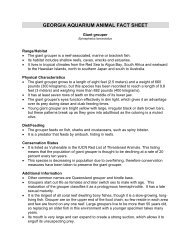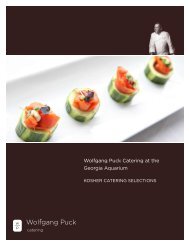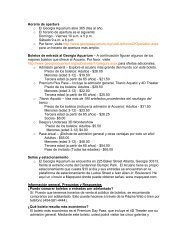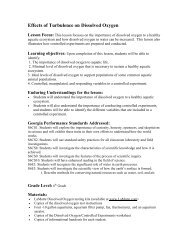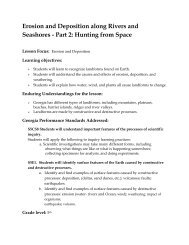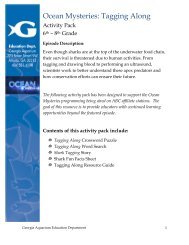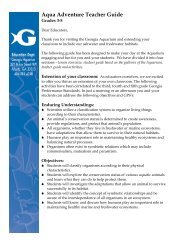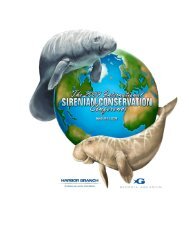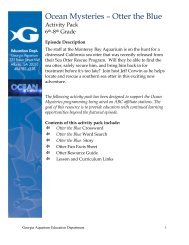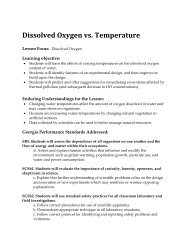Ecdysis in Arthropods - Georgia Aquarium
Ecdysis in Arthropods - Georgia Aquarium
Ecdysis in Arthropods - Georgia Aquarium
You also want an ePaper? Increase the reach of your titles
YUMPU automatically turns print PDFs into web optimized ePapers that Google loves.
<strong>Ecdysis</strong> <strong>in</strong> <strong>Arthropods</strong>Lesson Focus: Molt<strong>in</strong>g/<strong>Ecdysis</strong> <strong>in</strong> Phylum ArthropodaLearn<strong>in</strong>g objectives:‣ Students will <strong>in</strong>vestigate how <strong>Arthropods</strong> grow‣ Students will discuss why <strong>Arthropods</strong> shed their exoskeleton‣ Students will explore how <strong>Arthropods</strong> replace their exoskeletonEndur<strong>in</strong>g Understand<strong>in</strong>gs for the lesson:‣ Hav<strong>in</strong>g an exoskeleton rather than an endoskeleton presents unique challengesto arthropods not faced by other animals.‣ <strong>Ecdysis</strong> uses a process that makes arthropods very vulnerable <strong>in</strong> order to providethem with enhanced strength and survival abilities later.<strong>Georgia</strong> Performance Standards Addressed:SZ4 Students will assess how animals <strong>in</strong>teract with their environment <strong>in</strong>clud<strong>in</strong>g keyadaptations found with<strong>in</strong> animal taxa.a. Discuss morphological & physiological adaptations relative to ecological rolesb. Relate animal adaptations, <strong>in</strong>clud<strong>in</strong>g behaviors, to the ecological roles playedby animalsc. Expla<strong>in</strong> various life cycles found among animals (e.g., polyp and medusa <strong>in</strong>cnidarians; multiple hosts and stages <strong>in</strong> platyhelm<strong>in</strong>thes life cycle; arthropodmetamorphosis; egg, tadpole, adult stages <strong>in</strong> amphibian life history).Grade level: Junior and Senior ZoologyMaterials:Specimens of various <strong>Arthropods</strong>Video of the Blue Crab Molt<strong>in</strong>gCrab exoskeletonsTime needed: Approximately 90 m<strong>in</strong>utesBackground <strong>in</strong>formation: <strong>Arthropods</strong> are multicellular, eukaryotic, heterotrophicorganisms thus classify<strong>in</strong>g them as members of K<strong>in</strong>gdom Animalia. They areeucoelomate protostomes with well-developed organ systems, and cuticularexoskeletons conta<strong>in</strong><strong>in</strong>g chit<strong>in</strong>, which place them <strong>in</strong> the phylum Arthropoda. Thisphylum represents the largest group of liv<strong>in</strong>g animals on Earth. It <strong>in</strong>cludes spiders,scorpions, ticks, mites, crustaceans, millipedes, centipedes, <strong>in</strong>sects and several other
Evaluation:‣ Have students compare/contrast <strong>in</strong> an essay the growth of animals that have anexoskeleton and ones that have an endoskeleton‣ Evaluate the student’s pre and post lab ideas regard<strong>in</strong>g the production andma<strong>in</strong>tenance of an arthropod’s exoskeleton.‣ Ask students to expla<strong>in</strong> <strong>in</strong> essay format on the chapter test: the process used by adecapod to not only shed an exoskeleton, but also how to reform a new one andthe steps taken for protection dur<strong>in</strong>g the process.Extensions:‣ Have students compare the pros and cons of hav<strong>in</strong>g an exoskeleton.‣ Have students compare the anatomy of an arthropod with other <strong>in</strong>vertebratesand vertebrates.‣ Have students identify and classify various <strong>Arthropods</strong> as well as compare andcontrast each Arthropod subphylum.Resources:‣ Animal Diversity, Hickman and Roberts, 1995‣ Blue crab facts from South Carol<strong>in</strong>a DNRhttp://www.dnr.sc.gov/mar<strong>in</strong>e/pub/seascience/bluecrab.html‣ Blue crab facts and pictures from Blue crab Info: http://www.bluecrab.<strong>in</strong>fo/‣ Altamaha River Keeper for the Blue Crab molt videoLesson developed by: Arron Haynes, Dawson County High SchoolThis activity is a product of the Rivers to Reef Teacher Workshop sponsored by the <strong>Georgia</strong><strong>Aquarium</strong> and Gray’s Reef National Mar<strong>in</strong>e Sanctuary that the author participated <strong>in</strong>. Formore <strong>in</strong>formation about this workshop, <strong>Georgia</strong> <strong>Aquarium</strong>, or NOAA Gray’s Reef NationalMar<strong>in</strong>e Sanctuary, please visit our websites at www.georgiaaquarium.org orhttp://graysreef.noaa.gov/



